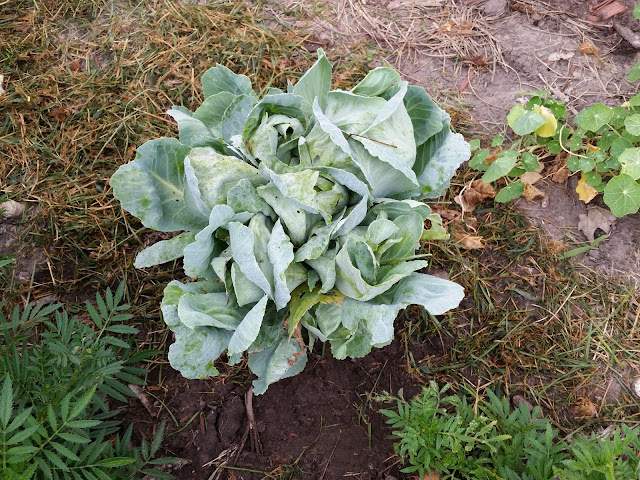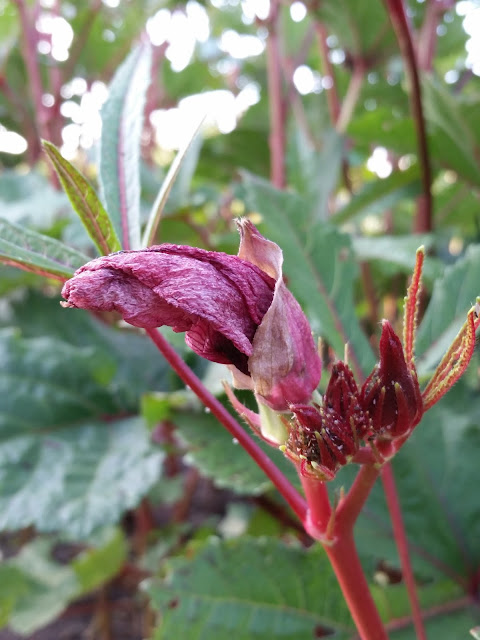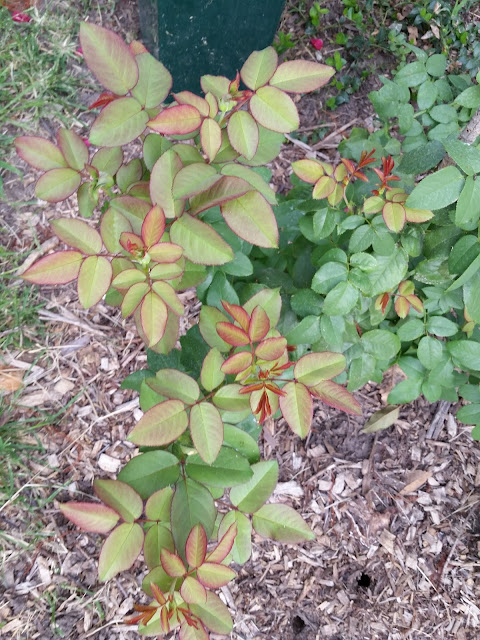Since we had August weather in June, I suppose it's only fair that we have June weather in August. The last week, and forecasted for the rest of this week, the temperature is holding in the low 80s. Very nice.
Fall plantings of lettuce, carrots and beets are up, along with transplants of cabbages. Since I never planted any fall crops before, I don't know how this will go, but I'm up for whatever grows.
New lettuce
I still have several of the older cabbage heads that I harvested without uprooting and got a flush of small heads forming on each one. I'm interested to see if they get to be a harvestable size.
Golden beets
The cucumbers petered out in the heat. I wonder if they'll pick up again with the cooler weather we've been having.
Cat and cucumbers
I did manage to can a few jars of pickles from them.
The pepper plot is coming on and producing jalapeños, bell peppers, mini bells and something I didn't order that looks like it's probably a cross between different varieties of hot peppers I planted in a previous year and collected seed.
Overcrowded pepper patch
Because I started so many flowers this year, I ended up getting my peppers started late. They're just now producing. Only the jalapeños are harvestable yet. The bells I planted from seed of peppers I bought in the produce section will be a surprise, because I don't remember what colors I planted.
Bell peppers
Possible cross between red chilies and 'Black Hungarian'
The limas are full of blossoms and a few new pods. There won't be nearly enough beans to satisfy, because I love baby limas simply boiled and buttered. But I hate to harvest them. It's a pain in the neck, back and everything else to pick out the ones that are ready and leave the others to keep growing - it's not so easy to tell which is which. And you have to stand on your head to do it. Ideally, I'd have some raised beds for lima beans.
Tomatoes are ripening daily. This is the best year I've had yet for tomatoes. I don't know why that is, but I'm very pleased. I'll have lots of soup base and sauce come winter.
Tomato plants growing out the top of their cages
'Black Beauty'
'Gold Medal' - at first, they're mostly yellow, and when fully ripe, they're mostly red
- and much tastier
'Missouri Pink Love Apple' (in basket); 'Black Beauty' and 'Gold Medal'
Out of all the tomato seedlings I started, I kept and planted two each of 'Missouri Pink Love Apple', 'Gold Medal' and 'Black Beauty'. The two 'Gold Medal' plants are different from each other. One of them is what I expected looking at the picture and description in the online seed catalog: red and gold mottled. The other is a throwback that's all gold, more uniformly rounded, a bit smaller, and with lemon-colored flesh.
Ready for the freezer
I've been putting crystalized coyote urine around the bottom of my tomato plants, which has kept raccoons and other critters away. Apparently I didn't get fresh crystals out soon enough recently:
Raccoons know precisely when tomatoes are at their peak ripeness.
The okra has been producing nicely, as okra always does in summer heat. 'Jing Orange' is shoulder high, and 'Red Burgundy' is as tall as I am. 'Jing Orange' pods are stout and heavily ridged. 'Red Burgundy' pods are darker red, thin and more flat-sided. They taste alike.
Rhubarb (foreground); 'Red Burgundy' okra (middle left); 'Jing Orange' okra (middle right); tomatoes (background)
All stages of the plant are present at this time of the year.
New flower bud
Flower unfurling
Flower in full bloom
Flower re-furled and fading
Dead flower being cast off a new green pod beside dark red day-old pod
(with new flower buds also forming in the cluster)
Newly exposed green fruit pod
New flower and growing pod. The pods will remain green if the old flower fails to fall, leaving them unexposed to sunlight. This one in the picture above obviously had a piece of the flower petal stuck onto its mid-section for a while.
'Jing Orange' okra: Perfect
I've battled the dreaded Japanese beetles since the second week in June - two whole months and I'm still finding some. They riddle the okra leaves and destroy the flowers - so irritating and frustrating, but absolutely infuriating when they're destroying my roses!
Japanese beetles on okra leaf (above) and flower (below)
Aaaaaaaaaaaaaargh!
Late summer: 'Jing Orange' okra (back tier); 'Henderson's Bush' lima beans (mid tier);
fall carrots (front left); zinnia mix (right); marigold mix (far right)
The zinnias are still going strong.
Over in the cut flower garden, the Dahlias are still blooming, but the blooms are getting smaller and smaller. The pepper plants I started from the seed of one 'Black Pearl' ornamental pepper are all different, but all lovely.
'Black Pearl' offspring
Mixed Dahlias (foreground) and butterfly milkweed; black-eyed Susan in background
I read recently that butterfly houses are essentially just ornaments since butterflies don't normally use them. I have one in my cut flower garden, and I planted butterfly milkweed - food for the Monarch butterflies - next to it, hoping to provide a home for them. Oh well, at least they can still eat.
The last of the 'Golden Zucchini' plants essentially stopped producing and started wilting, so I pulled it out. (It was actually producing green fruit. I've had a number of surprises with seeds I planted this year.)
The 'Golden zucchini' (that was actually golden) I planted on the compost heap didn't produce much. It's dying now and full of squash bugs (which is probably why it's dying). Those in the tomato cage had hardly any on them - that was a surprise, since I've always seen this type of infestation with zucchini I've let sprawl on the ground:
Various stages of juvenile squash bugs on zucchini
So it must now be time for some insect pix:
1-1/2 inches of Japanese beetles
Tachinid fly
Note this guy's appearance compared to your houseflies, because this guy is a beneficial insect, and you don't want to kill it. I hesitate to tell you how it's beneficial, because it's not pleasant, but here goes: It lays its eggs on caterpillars in a substance that makes them stick on. When the eggs hatch, the little fly larvae bore into the caterpillar and feed on its insides slowly killing it.
Remember this guy?
In a previous post, I asked if anyone knew what this ladybug type beetle is. Nobody came up with an answer, but I did find a website where I could ask for ID. I didn't get an answer from them, either, but then I found another site:
Iowa State University Bug Guide. I posted the picture there and within a half hour (!) I had a response: Milkweed leaf beetle (
Labidomera clivicollis). Thank you bug people! (Specifically: Maggie Furtak)
Painted lady butterflies are out in force.
I've finally seen a couple of Monarch butterflies in the last week or so. The one in the picture below is feeding on Echinacea (purple coneflower).
To differentiate the Monarch from the Viceroy is easy even if you don't see them together to note that the Monarch is larger: the Viceroy has a black band parallel to the edge of its back wings.
The Viceroy in the picture above is perched on bee balm - Monarda - which has finished blooming for a couple of weeks now.
So, you can tell which one the butterfly in the picture below is. I promise I didn't kill it. I found it dead in the grass, and the dragonfly beside it dead on the patio.
The wildflowers still in bloom are mostly Echinacea and Rudbeckia (black-eyed Susan). There's also a bit of the beautiful wild blue Salvia (Salvia azurea).
The rose garden has already been worth all the work that went into it. I just hope I can overwinter the plants successfully and see what they look like when they get well-established.

I've had no problem with black spot on these roses, and I'm going to attribute that not to the resistance some of them are supposed to have, but to a preventative spray I read about and tried: 1 part milk to 2 parts water. Sounds crazy, but even 'Julia Child', which had severe black spot problems in the past three years since I've had it, hasn't had any this year. I sprayed the plants every five or six days in the spring when the weather was damp and cool, and haven't sprayed them at all for six weeks or more. I also pruned them early in the spring to get all the extraneous inner leaves out of the way of air flow. And, lest I might figure it just wasn't a bad year for black spot, there's an older rose out in the yard I didn't spray that has no leaves at all on it right now because they all dropped from black spot. When you look at the following pictures, take note of how nice the foliage looks - no chemicals!
When 'Grand Amore' first bloomed this spring, I didn't think I was going to be that impressed with it, but I was wrong.
'Pink Enchantment' hasn't performed as well as the one I lost by the house, but I'm expecting greater things once it gets back in the swing of things after some heavy winter damage. It would do better if those dastardly Japanese beetles would leave it alone.
The new foliage is lovely.
And when a flower does get to open undisturbed, it's very nice indeed.
Every time 'Shazam!' puts out a new flush of blooms, it outdoes itself from the previous flush. I've got to get some cuttings to root this fall so I don't lose this beauty.
'Pat Austin' blooms are gorgeous. Before they fade, they're a rich canteloupe orange. The only complaint I have is that their stems are thin and flimsy, so their heads flop. I'm hoping that's just because this is their first year.
'Charles Darwin' is another David Austin rose. It's been really weird. I was expecting yellow, and sometimes I get yellow. Sometimes I get peach; sometimes pink. I hope that sraightens out after this, it's first, year, as well.
'Julia Child' is unmistakenly, screamingly yellow. She's not in my rose garden, though. She's up by the house.
'Til next time. (I'll be watching the total solar eclipse on the 21st. Hope you're somewhere you can see it, too.)




























































































